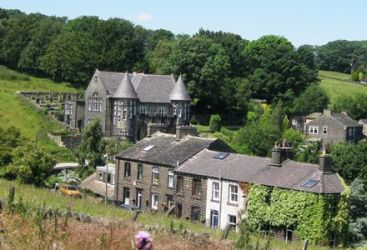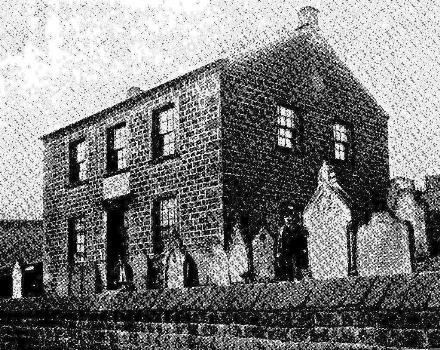
Boulderclough United Methodist Church
This is quoted from a history of the Church in Boulderclough written in 1922 on the occasion of their Centenary celebrations at Easter of that year. Unlike the other churches in the Sowerby district, Boulderclough owed no allegiance to St Peters Church whatsoever."The years 1821-22 became notable in Boulderclough through visits of certain persons, who because of their religious zeal and constancy proclaimed the wonderful Gospel of Jesus in experimental expressions of heart testimony, which testimony was accepted by a portion of the community resident in the district."

He began his missionary work in the spring of 1821 starting at Elland working on his organised route and quickly established churches on the circuit that he passed through. Boulderclough was one of these villages on his missionary circuit. When he first visited Sowerby, he took his stand as a missionary evangelist at Carr Fold, Sowerby Green and Boulderclough amongst other places. The people were attracted, became interested and associated themselves with him. Classes for prayer and praise were decided upon and catered for in peoples homes, with the final outcome that it was found desirable to have a central building for their religious worship.
Families in the village started to search for a suitable site, this was found at Far Bank (locally called Scott's bank) situated on the Sowerby to Mytholmroyd road, terms of agreement were entered into and it became the position for the Church of "Boulderclough". The foundation stone was laid in 1820 in the presence of the Rev Holliday, the stone being obtained from the Quarry in the village. The ground, buildings etc. of the Church as far as could be traced cost £900.
The story is told that before any place of worship (for the Primitive Methodist's) was erected in the village an aged woman named Fanny Barraclough often made the subject a matter for prayer. The people in those days were not well off financially as now, but the people were representative of the men and women of "Nehemiah's day" they had to work and give. The men quarried the stone at the delph and helped to dig the foundation, others loaned carts and horses to convey the stone to the site. The women carried food and drink for the workers and eventually the foundation stone was laid, upon which the magnificent new structure of millstone grit was erected.

The organ did not survive long and a visiting minister turned to the congregation and remarked "I think friends, that your organ has got bronchitis". November 1876 saw the installation of a new organ costing £220 which, at the demolition of the old Church, was removed and stored at Swamp Mill. At the completion of the new Church the organ was brought back and remodelled and a special Tremolo stop inserted.
The old Church was a well built and durable structure with a flag pavement floor, which was found to be very cold and uncomfortable to kneel upon, these flags were covered with boards in 1859. The heating of the premises was also found to be unsatisfactory by the "fire chambers" at either side of the interior of the building therefore a large stove was placed in the bottom about central to the room around which the people and scholars congregated.
The people of later generations despite being generally satisfied with their inherited Church desired a more modern building with better internal arrangements so in 1888 it was decided to prepare for the Church's replacement, deciding to stop spending on the old building and instead look into the possibility of erecting a new Church building. Since 1885, sales of work were arranged for obtaining and increasing funds. Old scholars' gatherings and concerts were promoted to raise funds. In the space of ten years 1885-1896 besides paying all dues and demands relative to necessary repairs etc. there was an accumulation of £1446 towards building the new Church.
As soon as permission was granted the contractors commenced to take off the roof and raze the Church, the frontage stones of the old Church were preserved from harm, cleaned and relettered, and placed in the partition wall in the schoolroom. The rostrum chair, seating, cupboards, clocks etc. were all sold. The corner stones were brought from the Holy Land by Wilkinson Pickles and laid by him on August 28th 1897. The building is distinguished by the conical towers in the Arts & Crafts style.
The new structure presented a pleasing and unique appearance, and in the words of the architects, is of original and picturesque design. The principal features at the front being a portico with four arches, flanked at either side by a circular stair turret with high conical towers, somewhat after the style of a renaissance chateaux seen in France and Belgium. The Portico is reached by two flights of steps and it's ornamental doors lead into the vestibules.
Passing straight across the vestibules the schoolroom was entered, opposite the entrance to the schoolroom is a 2ft. high platform and behind the platform was a lecture room, arranged so that it can be divided into two classrooms by means of a roller shutter door. There was also a large kitchen. At the North West corner another external entrance was provided for the Minister with a flight of steps to the Minister's vestry on the floor above. Two other class rooms were also provided, also a choir vestry. From each of the vestibules an ornamental circular staircase lead to the Church above.

A public tea followed the opening services in October 1898 at which 380 were present, followed by a public meeting at which a brief report was read out, followed with songs, anthems and speeches. The proceeds from the whole of the opening services reached the noble sum of £153. But it took until February 1906 to finally pay off the debt.
In the later years the church became known as the Ranters Chapel, this developed from The Mutual Improvement Society which was founded in 1869. In the beginning it was the main source of education for the children and young people of Boulderclough, this education carried on until the education act was introduced requiring compulsory education for children. The Mutual Improvement Society then took a slightly different slant. It was here that members were first inspired with a thirst for knowledge and the desire to develop their powers of self expression, through reading books and allowing everyone to give out their own ideas, thoughts and opinions, on the various topics brought out in the class. Numerous themes were discussed, dissecting the good and bad points of both subject and speaker. The chair always maintained good order, always preventing the class degenerating into bedlam. Questions would sometimes evoke quick repartee and rowdy responses, but no meeting ever closed in a storm of disorder.
The Chapel was also the home of Ancient Order of Henpecked Husbands who had their annual meeting there every Easter Monday.
Times changed and it became necessary, in 1979, due to falling attendances to close the Church and amalgamate with Rooley Lane and Bolton Brow churches in the new Sowerby Bridge Methodist group, meeting at St Paul's Church, Tuel Lane. The building was then converted in private dwellings. The Church was licensed for marriages on 17th Aug 1901.
The first wedding in the new church took place 9th March 1901.
by John Kerridge